Aldershot Military Cemetery
Aldershot Military Cemetery is a burial ground for military personnel, or ex-military personnel. It is located in Aldershot Military Town, Hampshire. The Cemetery is also open for the interment of husbands, wives and children of all ranks, and for some civilians who have spent their working life with the army.
The Cemetery lies between Thorn Hill and Peaked Hill, and is bordered to the south by Ordnance Road. Entrance is from Gallwey Road, near where the old time-gun stood, and from Ordnance Road.
It is unlike any other military cemetery in the United Kingdom, for not only is it set on hills and small valleys in natural surrounds, but here, at rest, lie nearly 17,000 fighting men of nine nations. There are 692 First World War graves in the cemetery; the earliest bears the date 5 August 1914, and the latest 11 August 1921. Many of these graves are in plot AF. The 129 Second World War graves are in groups in various plots, the largest group in plot A containing 86 graves.[1] [2]
Early history

The Cemetery was first enclosed in 1856, and although a number of soldiers were buried on the site prior to that year, soldiers and their families were interred in the churchyard of the village parish church of St Michael the Archangel in nearby Aldershot before the cemetery opened.
In 1870 the cemetery became the responsibility of the senior Royal Engineers Officer in "The Camp." The Protestant portion of the cemetery was consecrated by Samuel Wilberforce, the then Bishop of Winchester, on 1 November 1870.
The Mortuary Chapel was built in 1879 on newly acquired ground that had previously been used as a signal post. It replaced a wooden chapel built lower down the slope at the time the cemetery was first opened; this burned down resulting in the permanent chapel being built. The cemetery is divided into sections according to religious denomination and conflict; for example, there are sections relating to the two World Wars, the Falklands War of 1982 and for children.
Present day
The graves are set in beautifully tended steep rolling grounds of 15 acres (6.1 ha), traversed by many tarmacadam paths. The area is well wooded with oaks, pines, firs and chestnut trees, interspersed with yew topiary and rhododendrons.
Some parts are of bracken and heather, that are typical of the Aldershot countryside nearby, and possibly this was how this land was in the days before "The Camp" was built and before the cemetery was opened in 1865. The graves themselves are mostly set amid the fine textured close-cut turf, the cemetery being bordered as a whole, by holly hedging. The most western part of the grounds, where some of the earliest headstones are to be found, has been intentionally allowed to become overgrown. The loftier parts of the ground offer pleasant views of the Surrey heathlands, that form some of the nearby Army training grounds.
Here, in surroundings familiar during their soldiering days, are the graves of the fighting men of all ranks and many nations, who have served, lived and died in Aldershot. Some of service personnel having died in the nearby Cambridge Military Hospital, from wounds or disease contracted while on active service overseas.
At one time the cemetery held the graves of 78 German soldiers who had died in this country as Prisoners of War, including that of Generalfeldmarschall Ernst Busch, 2 other German Army officers, 13 members of the Luftwaffe and 7 sailors; these were exhumed in February 1963 and were reburied at Cannock Chase German war cemetery in Staffordshire. The cemetery also held the graves of 25 Italian POWs who were similarly exhumed and reburied in an unknown location.[3] In addition, 17 victims of the Blackbushe Air Disaster of May 1957 are buried in the cemetery,[4] as well as over 50 Canadian soldiers of both World Wars, plus the graves of Poles, South Africans, Gurkhas, Belgians, Dutch, New Zealanders and one Russian,[5] amongst others.[6]
A Cross of Sacrifice stands on the summit of the hill overlooking the World War I burials.
Notable graves
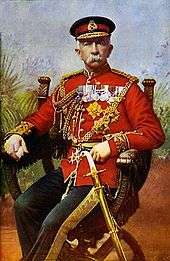
- Two defenders at the Battle of Rorke's Drift during the Zulu War of 1879 are buried in the cemetery. These are Sergeant Edward Wilson, 2nd Battalion South Wales Borderers and Cpl. D. Sheehan (who enlisted under the name James Graham) of the 90th Regiment (Perthshire Light Infantry).
- The headstone of Major William Davidson Bissett VC, recipient of the Victoria Cross in the latter part of the First World War. He was cremated in Pentrebychan Crematorium, Wrexham.
- Captain Henry Biziou, a British World War I flying ace credited with eight aerial victories.[7]
- Major-General Ronald Bramwell-Davis CB DSO, General Officer Commanding Aldershot District.
- Generalfeldmarschall Ernst Busch was temporarily buried in the cemetery between the graves of two German privates following a heart attack in July 1945. His funeral, which was performed with very little ceremony, was attended by Generalfeldmarschall Gerd von Rundstedt and eight other captured German generals.[8] His body was exhumed in 1963 and reburied in Cannock Chase German war cemetery in Staffordshire.
- Lieutenant Edward Teshmaker Busk RE(T), English pioneer of early aircraft design, and the designer of the first full-sized efficient inherently stable aeroplane.[9]
- General Sir Mervyn Butler KCB CBE DSO MC, former Commander-in-Chief of Strategic Command of the British Army.
- Samuel Franklin Cody, the early pioneer of manned flight, and often said (incorrectly) to be the only civilian grave in the cemetery.
- Mrs Louisa Daniell, philanthropist and founder of the Soldiers' Home and Institute in the town.
- Colonel George Armand Furse British army officer and author.
- Major Frank Goodden, the chief test pilot for the Royal Aircraft Factory located at Farnborough, Hants.[10]
- Lieutenant Henry Alan Leeke, a British track and field athlete who competed in the 1908 Olympic Games.[11]
- Lieutenant General Samuel Lomax, wounded at the First Battle of Ypres and died of his wounds in early 1915. He was cremated at Golders Green Crematorium.[12]
- Lieutenant Colonel Richard Lonsdale DSO & Bar, MC, who served with the Parachute Regiment throughout much of the Second World War.
- Captain Keith Lucas, British scientist, who died in an aircraft collision in World War I.[13]
- Sergeant Ian John McKay VC who died at Mt Longdon, East Falklands, an important objective in the battle for Stanley in the Falkland Islands.
- General Sir William Scotter KCB, OBE, MC Commander-in-Chief, British Army of the Rhine, from September 1978 until October 1980.
- Lieutenant General Sir Paul Travers KCB, former Quartermaster-General to the Forces.
- Field Marshal Sir Henry Evelyn Wood VC GCB GCMG. Recipient of the Victoria Cross, awarded for his part in putting down the Sinwaho & Sindhora Indian Mutiny of 19 October 1858.
Gallery
-

Grave of Sgt. Ian McKay VC
-
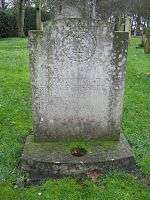
Grave of Major William Davidson Bissett VC
-
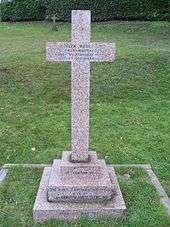
Grave of Field Marshall Sir Evelyn Wood VC, GCB, GCMG
-

Grave of aviator Samuel Franklin Cody
-
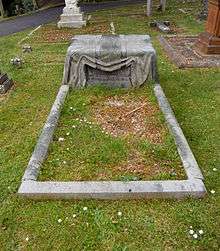
Grave of George Armand Furse
-

Grave of Major Frank Goodden
-
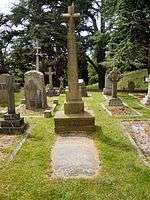
Grave of Edward Teshmaker Busk
-
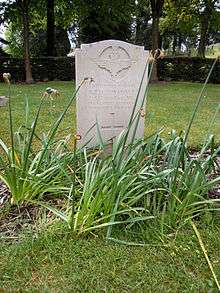
Lieutenant Colonel Richard Lonsdale DSO & Bar, MC
-
General Sir Mervyn Butler KCB CBE DSO MC
-
Headstone of Sir William Scotter KCB OBE MC
-
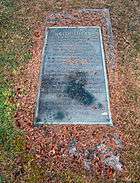
The grave of Keith Lucas
-
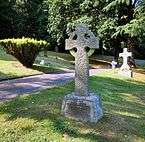
The grave of Ronald Bramwell-Davis
See also
- Aldershot Cemetery, the town's civilian cemetery but which also contains a number of military burials.
- Aldershot Crematorium
References
- The Story of Aldershot (A History and Guide to Town and Camp), Cole, Ltnt Col Howard N, OBE TD, 1951, Gale & Polden
- ↑ CWGC Cemetery report
- ↑ Katikati e-Memorial World War 1
- ↑ Ward, Daniel J., A Life Never Dies: Aldershot Military Cemetery Unknown publisher (c.1988) pgs. 1-2
- ↑ Ward, pg. 38
- ↑ CWGC Casualty record, Wassili Lukjanow, Russian Army, died 1945
- ↑ Ward, pg. 39
- ↑ "Biziou, Henry Arthur Richard". Commonwealth War Graves Commission. 2014. Retrieved 3 September 2014.CWGC Casualty record, Capt Henry Biziou
- ↑ Busch's funeral described in 'Some of the Prisoners held at Special Camp 11'
- ↑ CWGC entry CWGC Casualty record, Lt Edward Teshmaker Busk.
- ↑ "Casualty Details: Goodden, Frank Widenham". Commonwealth War Graves Commission. 2016. Retrieved 27 February 2016.CWGC Casualty record, Maj Frank Widenham Goodden.
- ↑ "Casualty Details—Leeke, Henry Alan". Commonwealth War Graves Commission.CWGC Casualty record, Henry Alan Leeke.
- ↑ Commonwealth War Graves database page for Lieutenant General Samuel Holt Lomax, Retrieved on the 14 March 2007
- ↑ CWGC Casualty record, Capt Keith Lucas
External links
| Wikimedia Commons has media related to Aldershot Military Cemetery. |
- CWGC: Aldershot Military Cemetery
- Rushmoor Borough Council
- Grave Location for Holders of the Victoria Cross in the County of Hampshire
- The British War Memorial Project
Coordinates: 51°15′19″N 0°44′49″W / 51.25528°N 0.74694°W
